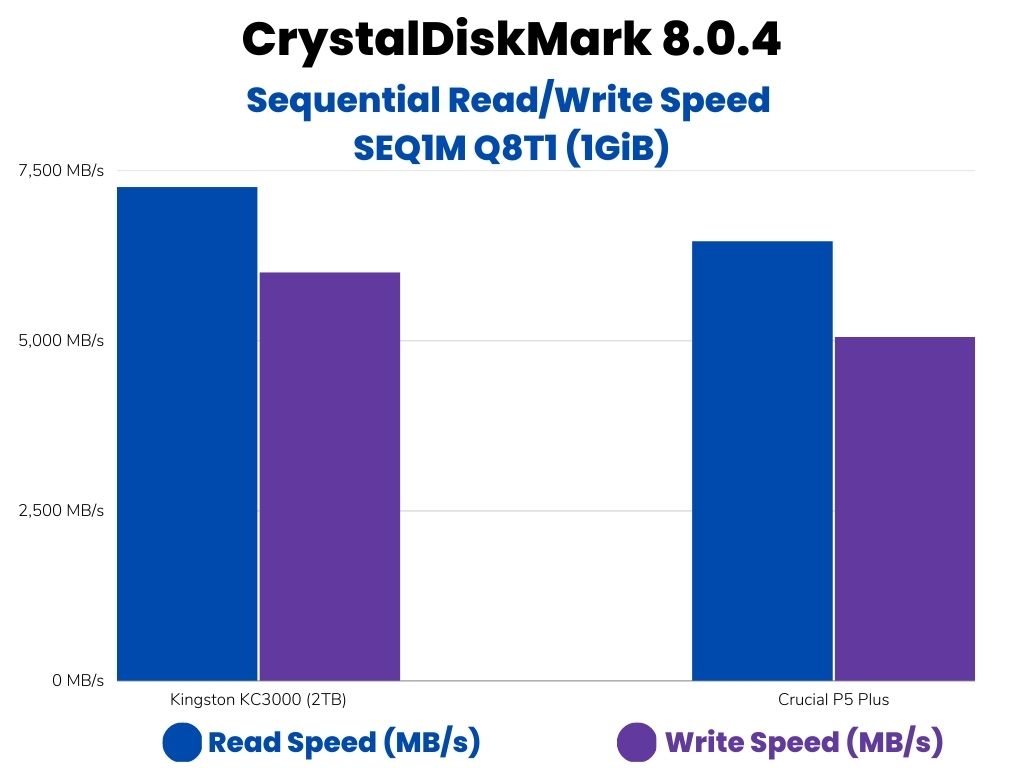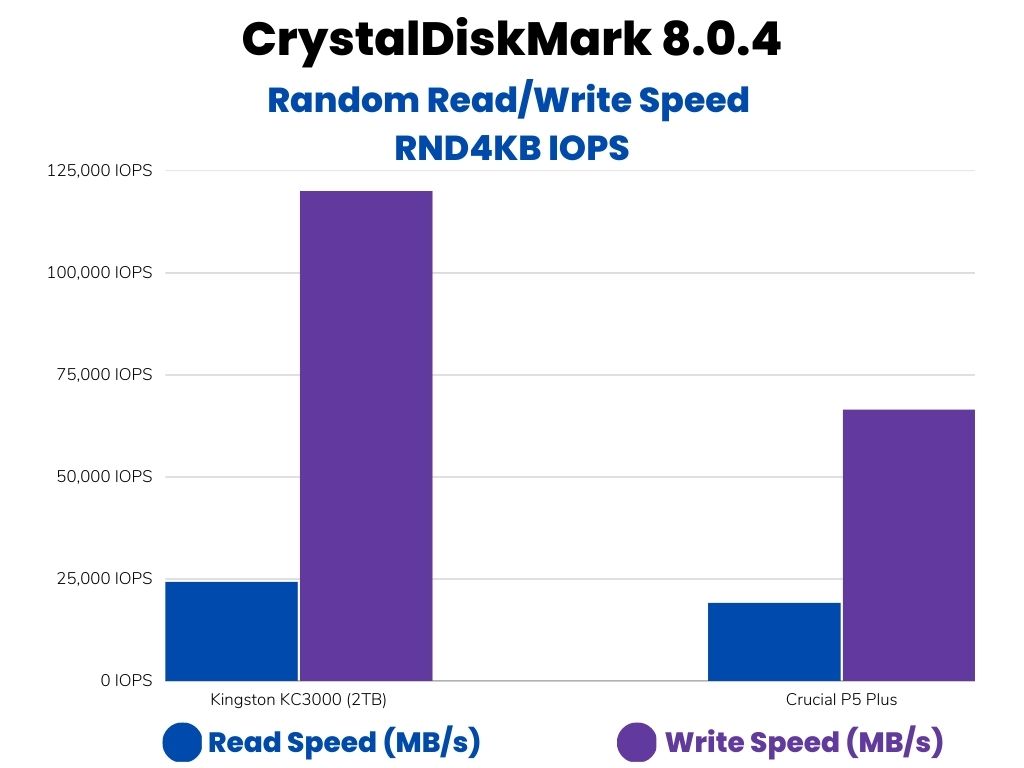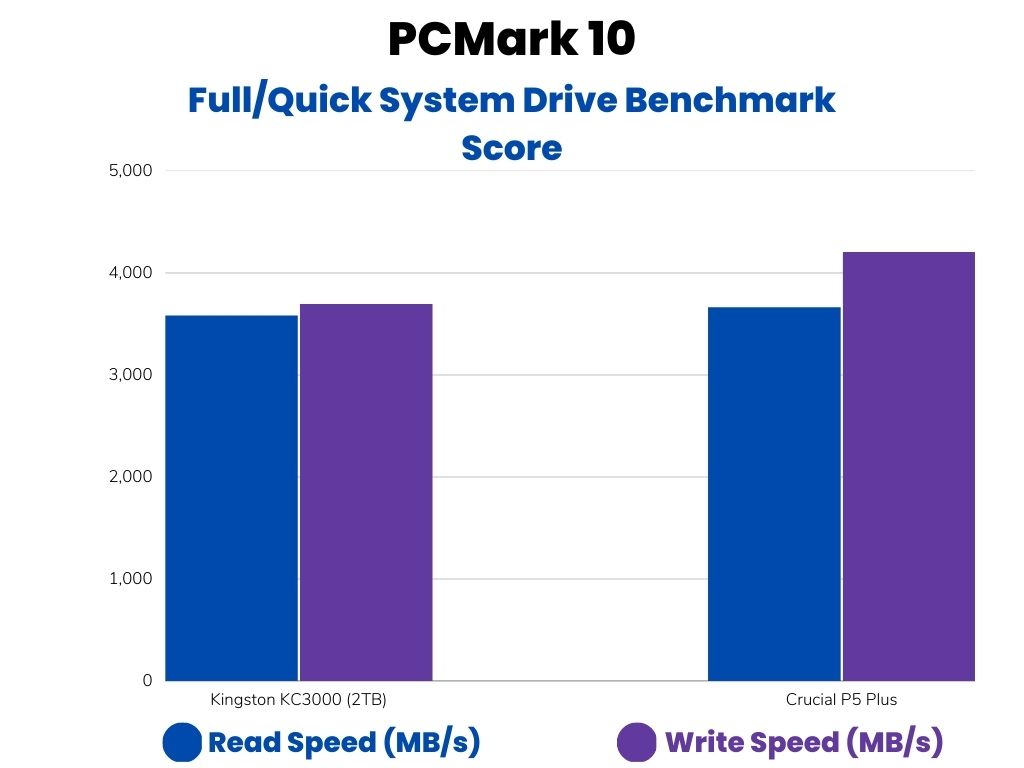After the arrival of these two Gen4 NVMe SSDs in the market, buyers are now much more confused about which one to choose. Yes, we are talking about Crucial’s and Kingston’s flagship SSDs i.e. Crucial P5 Plus and Kingston KC3000.
There are differences for sure. The KC3000 is much faster and equipped with much more features. However, the P5 Plus offers a great value-for-money proposition.
Both are based on the Gen4 NVMe technology and are considered high-end drives suitable for gamers, content creators, and other hardcore users.
If we talk about the maximum data sequential read speed, the KC3000 offers 7 GB/s while the P5 Plus can up to 6600 MB/s.
The highest write speed the KC3000 can reach up to 7GB/s again but the P5 Plus can reach only up to 5 GB/s.
These are the numbers claimed by the companies but the real performance is always tested on the ground. We will compare the benchmarks later below. So, without any delays, let’s get started.
Crucial P5 Plus vs Kingston KC3000 Theoretical Specs
| Specification | Kingston KC3000 | Crucial P5 Plus |
|---|---|---|
| Storage Variants | 512GB, 1TB, 2TB, 4TB | 500GB, 1TB, 2TB |
| Theoretical Read Speed (Seq) | Up to 7,000 MB/s | Up to 6,600 MB/s |
| Theoretical Write Speed (Seq) | Up to 7,000 MB/s | Up to 5,000 MB/s |
| Random Read Speed | Up to 1,000K IOPS | Up to 720K IOPS |
| Random Write Speed | Up to 1,000K IOPS | Up to 720K IOPS |
| Warranty | 5 Years | 5 Years |
| Heatsink Option | Not Available | Available |
| Encryption | Not Available | Available |
In terms of storage variants, the Kingston KC3000 offers a broader range of options with storage capacities of 512GB, 1TB, 2TB, and 4TB, whereas the Crucial P5 Plus is available in 500GB, 1TB, and 2TB capacities. This makes the Kingston KC3000 a more suitable option for users who require higher storage capacities, such as content creators or those who work with large files frequently.
We have already talked about the speed difference i.e. KC3000 is going to give you a better read/write speed in any situation.
One notable difference between the two SSDs is the availability of the heatsink option. The Crucial P5 Plus comes with an available heatsink option, which can help dissipate heat more effectively during prolonged and intense usage, thus ensuring consistent performance and longevity of the SSD. On the other hand, the Kingston KC3000 does not offer a heatsink option, which may make it more susceptible to thermal throttling under heavy workloads.
Another difference between the two SSDs is the availability of encryption. The Crucial P5 Plus offers encryption as a feature, which provides users with the option to secure their data using hardware-based encryption protocols, such as TCG Opal and AES 256-bit encryption. On the other hand, the Kingston KC3000 does not offer encryption as a feature, which may be a consideration for users who prioritize data security and privacy.
Benchmark Scores Comparison
The benchmark scores are compared with the 1TB variants of both SSDs. The results may vary depending on your variant and your overall system specs. My system specifications are as follows.
CPU: Intel Core i5 12600K
RAM: DDR5 4800 MHz (8x2GB)
Motherboard: MSI Pro Z690-A
OS: Windows 11 Pro
Sequential Read/Write Speed (CDM)

In conclusion, based on benchmark tests using Crystal Disk Mark, the Kingston KC3000 outperforms the Crucial P5 Plus in terms of sequential read/write performance. The KC3000’s higher sequential read/write speeds make it well-suited for tasks that involve reading or writing large files, such as video editing, data analysis, and file transfers.
The impressive performance of the KC3000 in sequential read/write speeds can significantly reduce loading times, accelerate data transfer rates, and improve overall system responsiveness, making it a great choice for high-performance computing environments where fast storage access is crucial for efficient workflow and productivity.
Random Read/Write Speed (CDM)

The higher random read/write speeds of the KC3000 make it well-suited for tasks that involve accessing multiple small files simultaneously, such as booting up an operating system, loading multiple applications, or performing database operations.
The faster random read/write performance of the KC3000 can significantly improve system responsiveness, reduce latency, and enhance overall computing experience, making it an excellent choice for users who require high-speed storage for tasks that involve frequent and intensive random read/write operations, such as gaming, multimedia production, and virtual machine operations.
PCMark 10 Full Drive Benchmark
PCMark 10 is a trace-based drive testing software. It utilizes real-world traces to replicate the gaming and application environment for the drives.

Surprisingly, the Crucial P5 Plus was capable of offering better results in the PCMark 10 tests. I did multiple tests to confirm the final results. But, this is the case. You can also see the Tom’s Hardware review of P5 Plus and these surprising PCMark 10 scores.
Endurance and TBW
| Parameter | Kingston KC3000 | Crucial P5 Plus |
|---|---|---|
| TBW | 512GB: 400 TBW 1TB: 800 TBW 2TB: 1,600 TBW 4TB: 3,200 TBW | 500TB: 300 TBW 1TB: 600 TBW 2TB: 1,200 TBW |
| Warranty | 5-Years Limited Warranty | 5-Years Limited Warranty |
| MTBF (Mean Time Between Failure) | 1.80 Million Hours | 2.0 Million Hours |
In conclusion, when it comes to endurance and TBW (Terabytes Written) ratings, the Kingston KC3000 SSD offers higher TBW values across all available storage capacities compared to the Crucial P5 Plus. With TBW ratings ranging from 400TBW for the 512GB variant up to an impressive 3,200TBW for the 4TB variant, the KC3000 is designed to handle intensive write workloads and provide reliable long-term performance.
The MTBF is a little higher with the P5 Plus.
Technical Specifications
| Technical Specification | Kingston KC3000 | Crucial P5 Plus |
|---|---|---|
| NAND Flash Type | Micron’s TLC | Micron’s TLC |
| NAND Flash Layers | 176 | 176 |
| Controller | Phison E18 | Micron DM02A1 |
| Controller Configurations | Triple-R5, 8-Channels | 6-Core |
| DRAM | DDR4 DRAM | LPDDR4 DRAM |
| Heatsink Option | Not Available | Available |
| T.R.I.M. | Available | Available |
| S.M.A.R.T. | Available | Available |
| Encryption | Not Available | Available |
| Details | Datasheet | Datasheet |
NAND Flash Specifications Comparison
| Specification | Kingston KC3000 | Crucial P5 Plus |
|---|---|---|
| Manufacturer | Micron | Micron |
| Name | B47R FortisFlash | B47R FortisFlash |
| Rebranded | FB25608UCM1-9E | MT29F4T08EQLEEG8-QB:E |
| Type | TLC | TLC |
| Technology | 176-layer | 176-layer |
| Speed (MT/s) | 1200 – 1600 | 1200 – 1600 |
| Capacity | 4 chips @ 2 Tbit | 2 chips @ 4 Tbit |
| ONFI | 4.1 | 4.1 |
| Topology | Replacement Gate | Replacement Gate |
| Die Size (mm²) | 50 | 50 |
| Gbit/mm² | 10.2 | 10.2 |
| Dies per Chip | 4 dies @ 512 Gbit | 8 dies @ 512 Gbit |
| Planes per Die | 4 | 4 |
| Decks per Die | 2 | 2 |
| Word Lines | 195 per NAND String | 195 per NAND String |
| Vertical Efficiency | 90.3% | 90.3% |
| Program Time (tProg) (µs) | 492 | 492 |
| Block Erase Time (tBERS) (ms) | 15 | 15 |
| Die Write Speed (MB/s) | 130 | 130 |
| Endurance (P/E Cycles) | up to 5000 (40000 in SLC) | up to 5000 (40000 in SLC) |
| Page Size (KB) | 16 | 16 |
| Block Size (Pages) | 2112 | 2112 |
| Plane Size (Blocks) | 550 | 550 |
The primary differences between Kingston KC3000 and Crucial P5 Plus lie in their capacity and dies per chip. The KC3000 features 4 chips at 2 Tbit each, while the P5 Plus has 2 chips but each at a larger 4 Tbit capacity. Additionally, the P5 Plus uses 8 dies per chip compared to KC3000’s 4.
These differences can impact the storage density and possibly the performance. More dies per chip in the P5 Plus could offer better parallelism, enhancing data transfer speeds under certain workloads. On the other hand, the KC3000’s configuration might be optimized for different types of storage tasks. Both drives otherwise share similar specifications, including speed, technology, and endurance.
Controller Specifications Comparison
| Specification | Kingston KC3000 | Crucial P5 Plus |
|---|---|---|
| Manufacturer | Phison | Micron |
| Name | PS5018-E18-41 | DM02A1 |
| Architecture | ARM 32-bit Cortex-R5 | ARM 32-bit Cortex-R5 + Cortex-M3 |
| Foundry | TSMC | Micron |
| Flash Channels | 8 @ 1,600 MT/s | 8 @ 1,600 MT/s |
| Frequency (MHz) | 1,000 | N/A |
| Core Count | 5-Core | N/A |
| Process | 12 nm | N/A |
| Chip Enables | 4 | 4 |
| Controller Features | DRAM (enabled) | DRAM (enabled) |
The Kingston KC3000 and Crucial P5 Plus controllers have a lot in common, such as the number of flash channels, chip enables, and DRAM features. However, they differ in architecture complexity, foundry, frequency, core count, and process size. These differences could offer varying advantages in terms of performance, power efficiency, and data handling capabilities.
Price


Which one to buy? KC3000 or P5 Plus
Kingston KC3000 is made for enthusiasts and gamers. So, if your demands are higher, you should go for the KC3000. It competes directly with top-end SSDs like the Samsung 990 Pro and WD Black SN850X. So, you can expect some amazing results from it.
However, if you are a little tight on the budget and good to go even with a slower Gen4 NVMe, P5 Plus will be good enough for you. It has all the things that any average user will need. In other words, if you don’t want to play high-end games or move huge files from one place to another, P5 Plus will be a great choice.
But, still, if you are searching for performance, KC3000 is the best option for you.
Let me know your thoughts in the comments.
your article is always good to read, can you please stated the publishing datesothat it will be good to refer ?